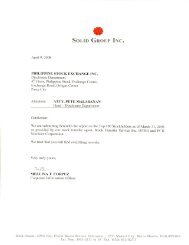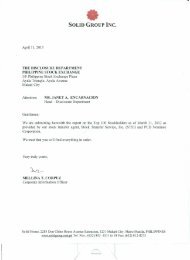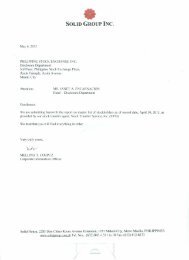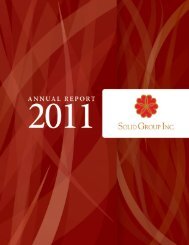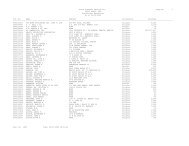SEC Form 17-A: Annual Report - the solid group inc website
SEC Form 17-A: Annual Report - the solid group inc website
SEC Form 17-A: Annual Report - the solid group inc website
You also want an ePaper? Increase the reach of your titles
YUMPU automatically turns print PDFs into web optimized ePapers that Google loves.
- 13 -<br />
2.5 Financial Assets<br />
Financial assets are recognized when <strong>the</strong> Group becomes a party to <strong>the</strong> contractual<br />
terms of <strong>the</strong> financial instrument. Financial assets o<strong>the</strong>r than designated and effective<br />
as hedging instruments are classified into <strong>the</strong> following categories: financial assets at<br />
fair value through profit or loss (FVTPL), loans and receivables, held-to-maturity<br />
investments and AFS financial assets. Financial assets are assigned to <strong>the</strong> different<br />
categories by management on initial recognition, depending on <strong>the</strong> purpose for which<br />
<strong>the</strong> investments were acquired.<br />
Regular purchases and sales of financial assets are recognized on <strong>the</strong>ir trade date. All<br />
financial assets that are not classified as at FVTPL are initially recognized at fair value<br />
plus any directly attributable transaction costs. Financial assets carried at FVTPL are<br />
initially recorded at fair value and transaction costs related to it are recognized in profit<br />
or loss.<br />
Currently, <strong>the</strong> Group’s financial assets are categorized as follows:<br />
(a)<br />
Loans and Receivables<br />
Loans and receivables are non-derivative financial assets with fixed or<br />
determinable payments that are not quoted in an active market. They arise when<br />
<strong>the</strong> Group provides money, goods or services directly to a debtor with no<br />
intention of trading <strong>the</strong> receivables. They are <strong>inc</strong>luded in current assets, except<br />
for maturities greater than 12 months after <strong>the</strong> end of reporting period which are<br />
classified as non-current assets.<br />
Loans and receivables are subsequently measured at amortized cost using <strong>the</strong><br />
effective interest method, less impairment loss, if any. Impairment loss is<br />
provided when <strong>the</strong>re is objective evidence that <strong>the</strong> Group will not be able to<br />
collect all amounts due to it in accordance with <strong>the</strong> original terms of <strong>the</strong><br />
receivables. The amount of <strong>the</strong> impairment loss is determined as <strong>the</strong> difference<br />
between <strong>the</strong> assets’ carrying amount and <strong>the</strong> present value of estimated cash<br />
flows, discounted at <strong>the</strong> effective interest rate.<br />
The Group’s financial assets categorized as loans and receivables are presented as<br />
Cash and Cash Equivalents, Trade and O<strong>the</strong>r Receivables (excluding Advances to<br />
suppliers), Advances to Related Parties and Refundable Deposits (presented as<br />
part of O<strong>the</strong>r Current Assets) in <strong>the</strong> con<strong>solid</strong>ated statement of financial position.<br />
Cash and cash equivalents are defined as cash on hand, demand deposits and<br />
short-term, highly liquid investments with original maturities of three months or<br />
less, readily convertible to known amounts of cash and which are subject to<br />
insignificant risk of changes in value.



